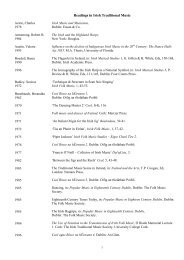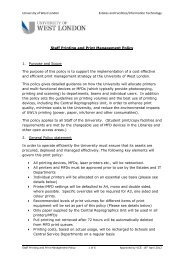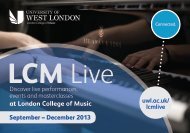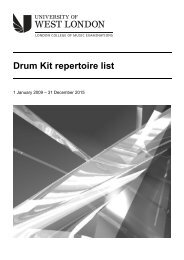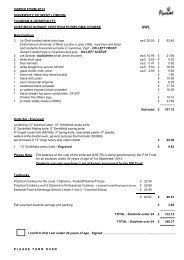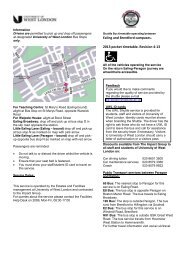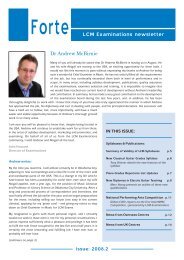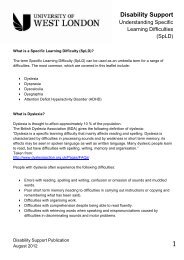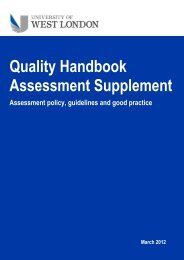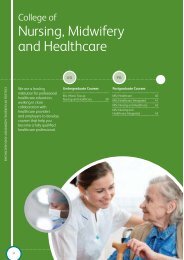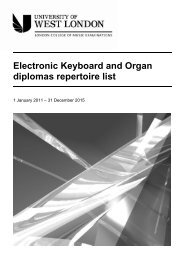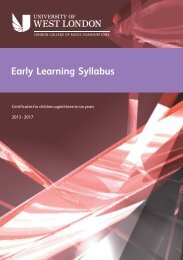LCM Exams - Church Music Diplomas - University of West London
LCM Exams - Church Music Diplomas - University of West London
LCM Exams - Church Music Diplomas - University of West London
- No tags were found...
You also want an ePaper? Increase the reach of your titles
YUMPU automatically turns print PDFs into web optimized ePapers that Google loves.
2.7 Description <strong>of</strong> Examination Components2.7.1 Dip<strong>LCM</strong> in <strong>Church</strong> <strong>Music</strong>Component 1: Solo PerformanceRefer to ‘Guidelines for Performance Component’ (Section 2.5).Candidates should compile and perform a recital <strong>of</strong> 15-20 minutes’ duration, consisting <strong>of</strong> a programme <strong>of</strong> musicsuitable for use in worship. This must include at least one piece suitable for use as a voluntary or incidental musicwithin worship, performed on the candidate’s principal instrument. The Dip<strong>LCM</strong> repertoire list for the instrument(s)selected may be used as a starting point for determining suitable material. In addition, candidates must perform atleast one <strong>of</strong> the following: a hymn, worship song, anthem, pointed psalm, vocal solo, Christian rock song, or othersimilar item. The programme should be completed with any other suitable material <strong>of</strong> the candidate’s choice.If the candidate wishes, one item in the programme may be performed on an instrument other than the candidate’sprincipal instrument, which may or may not be chosen from the list <strong>of</strong> approved instruments.The programme should be interesting, balanced and varied. Original and creative approaches to programme-buildingare encouraged. The recital must consist <strong>of</strong> more than one single work.Candidates are reminded that all items should be selected and presented in a manner which enables performanceskills at Dip<strong>LCM</strong> level to be properly assessed.Component 2: Viva VoceThe examiner will lead the candidate in a discussion about the music performed in Component 1. The candidate willbe expected to demonstrate detailed technical and contextual knowledge about the repertoire. Questions may beasked on the following:• explanation <strong>of</strong> musical symbols and terms as found in the scores;• basic formal, structural, tonal, harmonic, melodic and rhythmic structures;• background knowledge <strong>of</strong> the composer and the historical context;• the candidate’s personal response and approach to learning and performing the music;• how each item presented in Component 1 might be used in the context <strong>of</strong> a service or act <strong>of</strong> worship.Component 3: Sight Reading (or alternative test as appropriate)A test for the candidate’s principal instrument will be given. Candidates <strong>of</strong>fering voice as their principal instrumentmay select the requirements for either Classical Singing or Popular <strong>Music</strong> Vocals.3a. Pipe Organ: Keyboard Tests• Sight Reading (manuals and pedals): three staves;• Score Reading (to be played on manuals only): three parts, either SAB or ATB, the tenor part to be written intreble clef;• Transposition (to be played on manuals and pedals): a hymn tune, up or down a tone or semitone.Specimen tests are available (LL11673).3b. Electronic Organ & Keyboard: Chord Sequence OR Accompanying TestCandidate to select ONE <strong>of</strong> the following (before the tests are seen):1. Chord Sequence Test: A written chord sequence <strong>of</strong> 8 bars will be provided, using chord symbols. The candidatemay play through the sequence once. They will then be asked to play it adding an improvised melody line. Theperformance may be given with or without the use <strong>of</strong> a rhythm unit.2. Accompanying Test: An 8 bar piece will be provided written for right hand treble clef, left hand bass clef, withchord symbols. A melody will also be written for the examiner to play. The candidate may look at the piece, thenlisten to the examiner play the melody at a designated tempo. The candidate will then accompany the examineras he/she plays the melody once more. The accompaniment may consist <strong>of</strong> left hand chords only, or may pick up16




